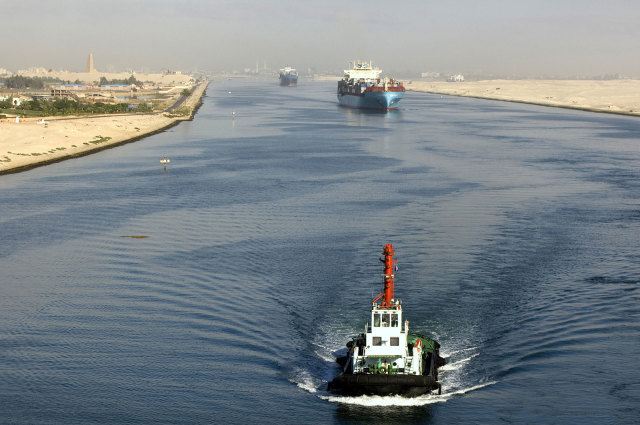The Suez Canal is an artificial sea-level waterway in Egypt, connecting the Mediterranean Sea to the Red Sea through the Isthmus of Suez. It is often considered to define the border between Africa and Asia. Constructed by the Suez Canal Company between 1859 and 1869, it officially opened on 17 November 1869. The canal offers watercraft a more direct route between the North Atlantic and northern Indian oceans via the Mediterranean and Red seas, thus avoiding the South Atlantic and southern Indian oceans and reducing the journey distance from the Arabian Sea to London, for example, by approximately 8,900 kilometres. It extends from the northern terminus of Port Said to the southern terminus of Port Tewfik at the city of Suez. Its length is 193.30 km including its northern and southern access-channels.
The original canal featured a single-lane waterway with passing locations in the Ballah Bypass and the Great Bitter Lake. It contains no lock system, with seawater flowing freely through it. In general, the canal north of the Bitter Lakes flows north in winter and south in summer. South of the lakes, the current changes with the tide at Suez.
The United Kingdom and France owned the canal until July 1956, when the President of Egypt, Gamal Abdel Nasser, nationalized it—an event which led to the Suez Crisis of October–November 1956. Under the Convention of Constantinople, it may be used "in time of war as in time of peace, by every vessel of commerce or of war, without distinction of flag". Nevertheless, the canal has played an important military strategic role as a naval short-cut and choke-point. Navies with coastlines and bases on both the Mediterranean and Red Seas (Egypt and Israel) have a particular interest in the Suez Canal.
In August 2014, the Egyptian government launched construction to expand and widen the Ballah Bypass for 35 km (22 mi) to speed the canal's transit-time. The expansion intended to nearly double the capacity of the Suez Canal, from 49 to 97 ships per day. At a cost of $8.4 billion, this project was funded with interest-bearing investment certificates issued exclusively to Egyptian entities and individuals. The "New Suez Canal", as the expansion was dubbed, was opened with great fanfare in a ceremony on 6 August 2015.

